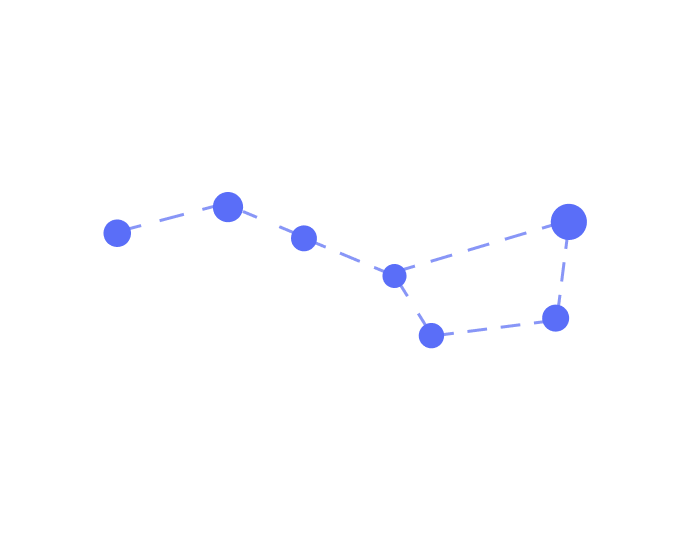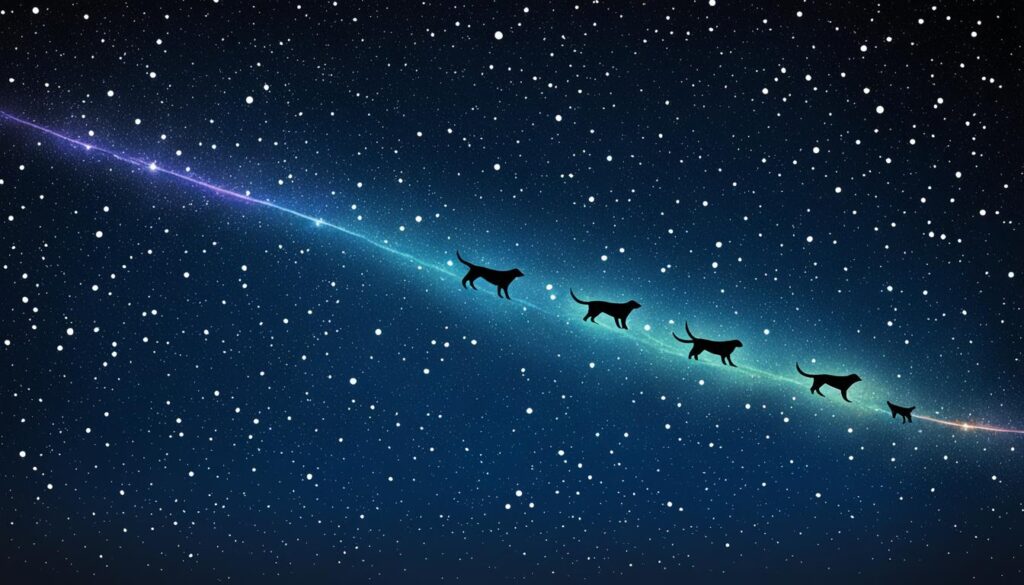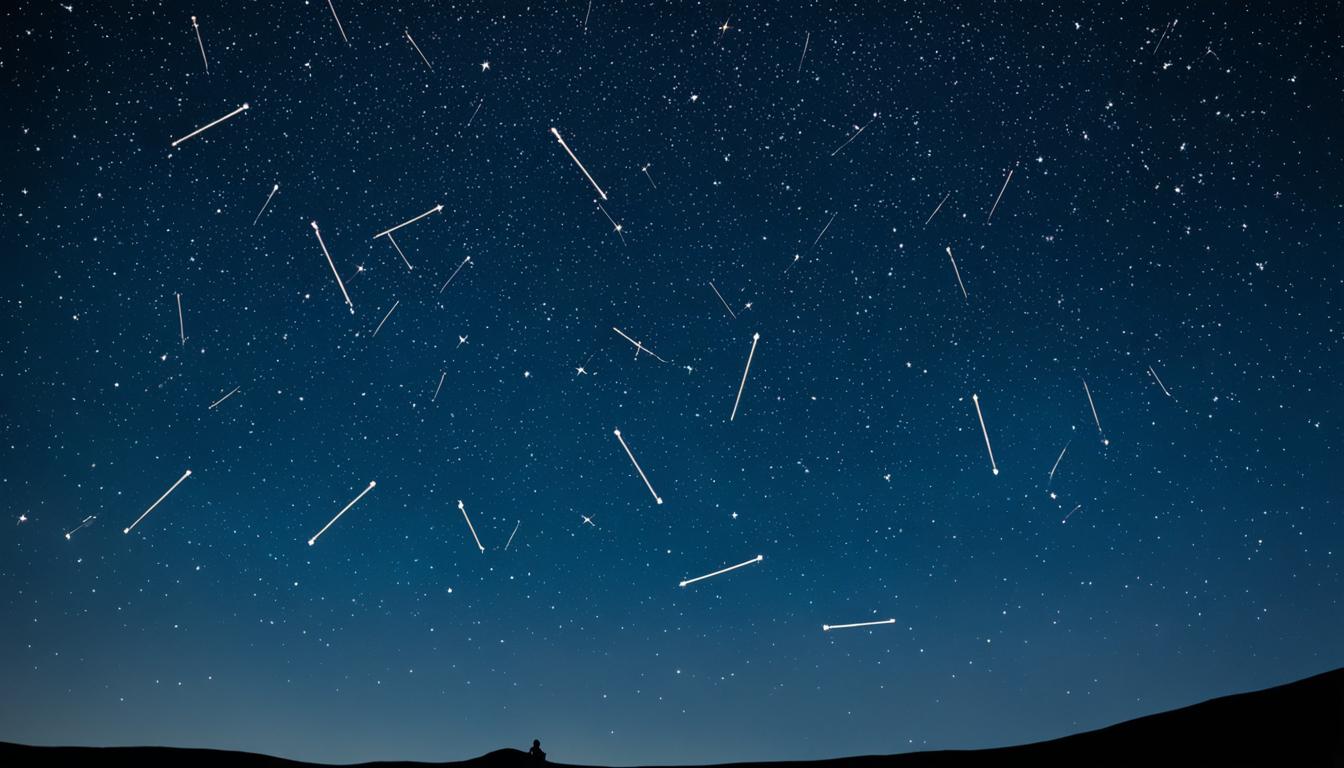
| Genitive | Canum Venaticorum |
| Abbreviation | CVn |
| Pronunciation | (KAY-neez vih-NAT-ih-seye) |
| Main Stars | 2 |
| Brightest Star | Cor Caroli (α CVn) (2.90m) |
| Right Ascension | 12 hours to 14 hours |
| Declination | +27.84 deg to +52.36 deg |
| Sq. Deg. Area | 465 |
| Crosses Meridian | 9PM, May |
| Visible Lat. Range | +90, -40 deg (°) |
| Best Viewing Season | Spring (Northern Hemisphere) |
As you gaze upon the night sky, you embark on a journey of celestial discovery, exploring the expanse where the constellation Canes Venatici decorates the cosmos with its stellar composition. Located in the third quadrant of the northern hemisphere, this constellation encompasses an area of 465 square degrees, positioned for optimal observation between the latitudes of +90° and -40°. Translated as “hunting dogs” from Latin, Canes Venatici is not just a cluster of stars but a portal into the rich tapestry of the universe. Stardust intertwined with the lore of Boötes’s loyal companions, this constellation serves as a beacon for star gazing enthusiasts and a foundational segment for any astronomy guide.
Attributed to the renowned Polish astronomer Johannes Hevelius in the late 17th century, Canes Venatici stands out among celestial wonders. With notable celestial objects such as the vibrant Cor Caroli and the crimson-hued La Superba, your curiosity through the realms of space is poised to be rewarded. Peer deeper and you’ll encounter the mesmerizing Whirlpool Galaxy (M51) and the elegant Sunflower Galaxy (M63), each a testament to the majestic firmament that Canes Venatici calls home.
Key Takeaways
- Discover Canes Venatici, a constellation replete with stellar and deep sky phenomena, ideal for astronomy aficionados.
- Learn about Canes Venatici’s history and its connection to the hunting dogs of Boötes, deepening your appreciation of this starry domain.
- Identify celebrated stars like Cor Caroli and La Superba, which add a vibrant narrative to the night sky’s allure.
- Uncover the essential role of Johannes Hevelius in the documentation and distinction of the constellation Canes Venatici.
- Explore profound celestial wonders such as the Whirlpool Galaxy and Sunflower Galaxy, nestled within the confines of Canes Venatici.
- Optimize star gazing sessions with knowledge of Canes Venatici’s position and best viewing times for astronomical observation.
The Historical Tapestry of Canes Venatici
Immersing yourself in the fabled skies, the constellation of Canes Venatici offers not merely luminous points for astronomical observation but a rich historical narrative as well. Looking past the star patterns and celestial objects, the legacy of Canes Venatici is entwined with ancient myths and a dash of serendipitous mistranslation that solidified its spot in the heavens.
Origins of the Constellation
Enshrined by Ptolemy as ambiguous stars in Ursa Major’s expanse, the constellation Canes Venatici emerged from obscurity through the insight of astronomer Johannes Hevelius. Its delineation in the 17th century marked a pivotal moment for celestial cartography, enriching the canvas of the night sky with new figures for spectators to admire.
The Story Behind the Hunting Dogs
The Hunting Dogs, known as Asterion and Chara, aptly complement the adjacent herdsman Boötes. This constellation’s journey from an erroneous translation—a twist of language where ‘club’ became ‘dogs’—to an established figure in the sky illustrates humanity’s enduring desire to find meaning amongst the stars.
The Influence of Johannes Hevelius
Your appreciation for Canes Venatici’s stellar domain is heightened when you consider Johannes Hevelius’s role. It was his hands that sculpted this constellation into existence, penning in 1687 a celestial story that has captivated star gazers ever since—evidence of human ingenuity sparked by the pursuit of astronomical observation.
| Name | Designation | Meaning | Notes |
|---|---|---|---|
| Chara | β Canum Venaticorum | Dear, Affection | Also known as a solar twin, enriching the storytelling embedded in the constellation. |
| Cor Caroli | α Canum Venaticorum | Heart of Charles | Lies in the heart of the constellation, shining as its brightest star. |
| La Superba | Y Canum Venaticorum | The Superb One | A red-hued carbon star, nicknamed for its stunning color and brightness. |
| Komondor | ASTERION Canum Venaticorum | N/A | A star less famed but contributing to the asterism’s overall pattern. |
| Tuiren | 24 Canum Venaticorum | N/A | Part of the lesser-known backdrop of stars supporting the constellation’s shape. |
Stellar Highlights of Constellation Canes Venatici
When you gaze upon the Constellation Canes Venatici, you capture a moment with the celestial hunting dogs, an area in the night sky that offers a spectacle for star gazing. This segment of the heavens is rich with stellar phenomena, presenting a tapestry of luminescence and cosmic variability. As you explore these stars, you’re connecting with the fabric of the universe—each star a story, every twinkle a history.
Brightest Stars: Cor Caroli and Chara
Cor Caroli, the alpha star of Canes Venatici, named after Charles I of England, is not only the brightest but also the most intriguing. This system is a splendid binary star consisting of two stars bound together by gravity, shining from around 110 light-years away. Chara, another gem in this constellation, sits closer at only 27.4 light-years away. This sun-like star has earned its place in the hearts of astronomers due to its similarities to our own solar luminary.
Solar Twins and Variable Stars
The constellation also houses stars like La Superba with its mesmerizing red coloration, and AM Canum Venaticorum, a star that exemplifies the cataclysmic nature of the cosmos with its dramatic brightness variations. Not to be overlooked, RS Canum Venaticorum weaves yet another layer of complexity into our celestial observations with its dynamism—a hallmark of the hunting dogs in the night sky.
A Guide to Star Color Variations within Canes Venatici
Each star within Canes Venatici possesses its own character, much like the hunting dogs this constellation represents. Akin to their earthly counterparts, star colors range from the robust reds of cooler stars to the fervent blues of their hotter siblings. These color variations provide not just a visual feast but also clues to the stars’ composition, age, and the fascinating physics driving their evolution.

| Name | Classification | Distance (light-years) | Apparent Magnitude | Color |
|---|---|---|---|---|
| Cor Caroli | Binary Star | 110 | 2.84 – 2.98 | White |
| Chara | Sun-like Dwarf | 27.4 | 4.83 | Yellow-White |
| La Superba (Y CVn) | Carbon Star | 710 | 4.99 – 7.30 | Red |
| AM Canum Venaticorum (AM CVn) | Cataclysmic Variable | Unknown | 14.1 | Blue |
| RS Canum Venaticorum (RS CVn) | Binary Star | Unknown | 8.9 | Orange to Red |
Navigating the Night Sky: Locating Canes Venatici
For those passionate about astronomical observation, pinpointing celestial objects like the distinct star patterns of Canes Venatici can be a transcendent experience. This constellation, nestled north of the celestial equator, shines predominantly for observers in the northern hemisphere. Canes Venatici, being circumpolar, conveniently never dips below the horizon for many northern observers, offering a spectacular year-round cosmic display.
Your journey to locate Canes Venatici begins by aligning your sights towards the neighboring constellations. It is flanked by Ursa Major to the west and Boötes to the southeast—key landmarks in the celestial canopy. The best time to catch this constellation in its full glory is when it culminates at its transit time, approximately at 03:51 UTC, ascending the night sky’s meridian and parading its celestial charms.

Let’s leverage available tools to enhance the astronomical observation experience. Modern resources such as sky charts and software act as your personal guides to the cosmos. Below is a comparative glance at these aids, assisting you to identify Canes Venatici with precision and ease:
| Resource Type | Utility | User Friendliness |
|---|---|---|
| Printed Star Maps | Offers comprehensive visuals of star arrangements. Ideal for hands-on learning and outdoor reference. | High for experienced astronomers; moderate learning curve for beginners. |
| Interactive Planetariums | Simulates the night sky on digital devices, allowing manipulation and exploration of celestial objects. | Very high, with intuitive interfaces suitable for all levels. |
| Mobile Astronomy Apps | Convenient for on-the-go identification with augmented reality (AR) features. | Very high; designed for both novice stargazers and seasoned observers. |
Whether you’re a seasoned sky watcher or a curious newcomer, spotting the mythological Hunting Dogs among the stars can be one of the most rewarding experiences. As you familiarize yourself with Canes Venatici’s star patterns, remember that each star serves as a portal to an unseen and distant universe. So, venture out, look up, and let the celestial hunt begin!
Mysteries of the Deep: Exploring Canes Venatici’s Deep Sky Objects
If you’re enticed by the allure of distant galaxies and interstellar phenomena, the constellation Canes Venatici offers a cosmic quest filled with deep sky objects that are simply too stunning to overlook. As you set your sights on this celestial canvas, you’ll encounter the elegance of the Whirlpool Galaxy (M51), a face-on spiral galaxy that interacts gravitationally with its smaller companion NGC 5195. This mesmerizing duo offers a splendid view for both amateur stargazers and seasoned astrophotographers, promising a celestial performance of galactic interaction and stellar creation.
In the pursuit of astronomical observation, Canes Venatici does not disappoint. Amid its starry realm, the Sunflower Galaxy (M63) shines with the grace of its spiraling arms, while Messier 106 challenges observers to distinguish its subtle details and active galactic nucleus. Less mentioned yet equally fascinating are Messier galaxies like the spherically clustered Messier 3, a globular ensemble of ancient stars that dance around a common gravitational center, presenting one of the brightest clusters visible to observers in the northern hemisphere.
Completing the constellation’s portfolio of heavenly attractions are the deep sky objects such as the Whale Galaxy (NGC 4631) and its nearby neighbor, the Cocoon Galaxy (NGC 4490), along with the Hockey Stick Galaxies (NGC 4656 and NGC 4657), each contributing their own unique brushstrokes to this astronomical masterpiece. As you delve into the depths of Canes Venatici, remember that each moment spent under its expanse is an opportunity to connect with the universe’s profound beauty and its intricate cosmic connective tissue. Will you heed the call of these celestial wonders and explore the deep sky treasures that await?
FAQ
What is the Constellation Canes Venatici?
The Constellation Canes Venatici, depicted as hunting dogs in the night sky, is a small constellation in the northern hemisphere. It is known for its celestial wonders including bright stars, deep sky objects like galaxies and star clusters, and represents the hunting dogs of the mythological figure Boötes, the Herdsman.
How can I locate Canes Venatici for star gazing?
To locate Canes Venatici, you will need to look north of the celestial equator. The constellation is best observed around its transit time at 03:51 UTC and can be easier to find if you’re viewing from the northern hemisphere. Consider using sky charts or an interactive planetarium to help identify this constellation among the surrounding star patterns.
What are some of the notable stars in Canes Venatici?
Significant stars in Canes Venatici include Cor Caroli, which is the brightest star in the constellation, and Chara, a sun-like star. Others like La Superba are appreciated for their color variations. These stars contribute to the unique astronomy guide experience that Canes Venatici offers to star gazers.
Who discovered the Constellation Canes Venatici and when?
The Constellation Canes Venatici was officially introduced by the Polish astronomer Johannes Hevelius in 1687. Hevelius is credited with establishing it as a constellation separate from Ursa Major, largely based on a historical translation error that mistakenly interpreted “club” as “dogs.”
What deep sky objects are located in Canes Venatici?
Canes Venatici is home to a variety of deep sky objects that entice astronomers and enthusiasts alike. Some of these objects include the Whirlpool Galaxy (M51), the Sunflower Galaxy (M63), Messier 106, and the globular cluster Messier 3. These celestial objects provide a window into the astronomical observation of galaxies and star clusters.
Are there any Messier galaxies in Canes Venatici?
Yes, Canes Venatici contains several Messier galaxies, such as the Whirlpool Galaxy (M51), the Sunflower Galaxy (M63), and Messier 106. Messier objects, named after French astronomer Charles Messier, are some of the most famous deep sky objects easily traceable in this constellation.
What is the brightest star in Canes Venatici and what’s special about it?
The brightest star in Canes Venatici is Cor Caroli, also known as Alpha Canum Venaticorum. It’s a binary star system, consisting of two stars with unique chemical peculiarities, and its magnitude varies between 2.84 and 2.98. The name “Cor Caroli” means “Charles’s Heart,” traditionally attributed to King Charles I of England.
Can Canes Venatici be seen all year round?
Yes, Canes Venatici can be seen throughout the year from the northern hemisphere as it is circumpolar to many northern locations. However, it is most visible in the spring months when it is highest in the sky during the evening hours.
What is the mythology behind the constellation Canes Venatici?
The mythology of Canes Venatici involves the figure of Boötes, the Herdsman, who is said to be accompanied by two hunting dogs represented by this constellation. The constellation’s formation was influenced by an error in translation from Greek to Arabic to Latin, which creatively turned a “club” into two “dogs.”
Are there any star color variations in Canes Venatici?
Stars within Canes Venatici exhibit a range of color variations. For instance, the red vibrant hue of La Superba (Y CVn) is a result of its cool surface temperature, while other stars like blue-white Cor Caroli show color due to their hotter surface temperatures. These color variations add to the visual interest and complexity of this constellation.






